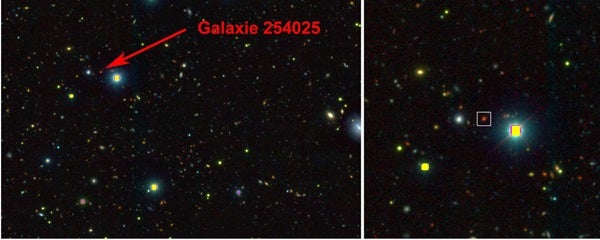An international team of astronomers led by Masato Onodera at the Commissariat a l’Energie Atomique in France has used the Subaru Telescope to take infrared spectra of a distant, unusually bright, and massive elliptical galaxy. This galaxy is 10 billion light-years from Earth, and we are seeing it at a time when the universe was only about one-quarter of its current age. Paradoxically, and in contrast to some previous studies, this galaxy appears to be similar to its cousins in the local universe. Its size appears to be normal for its mass, and its velocity dispersion is consistent with its large size. This research deepens the puzzle as to how and why some elliptical galaxies seem to reach their full size early in the evolution of the universe while other, compact ones, increase in volume over time.
Giant elliptical galaxies are the universe’s most massive galaxies near Earth. They have a regular, oval shape and lack the disk typical of spiral galaxies such as our own Milky Way. Using large telescopes, astronomers have identified elliptical galaxies over ten times more massive than the Milky Way and as far away from Earth as 10 billion light-years. Observing the light from such distant elliptical galaxies permits the direct study of how they looked shortly after their formation and opens a window to exploring the universe’s past.
Five years ago, long-exposure images from the Hubble Space Telescope (HST) suggested that distant elliptical galaxies might be two to five times smaller than nearby, local ellipticals of the same mass. If these findings were accurate, then the densities of the more distant ellipticals are 10 to 100 times higher than that of the local ones. Since then, experts have debated how these compact galaxies could expand over the intervening 10 billion years so that they matched the size of their local counterparts. Many questioned whether the measurements of the size of the distant ellipticals were accurate. Could some measurement error or bias account for their apparently small size?
To address this question, Onodera’s team turned to one of the world’s largest censuses of the distant universe, the Cosmic Evolution Survey (COSMOS), to find new candidates for the most massive, distant, giant elliptical galaxies. They looked for objects with a unique “fingerprint” of visible and near-infrared light as measured by Subaru’s Prime Focus Camera (Suprime-Cam) and the Canada-France-Hawaii Telescope’s Wide-field Infrared Camera (WIRCam). Finally, they used the COSMOS team’s unique database of high-resolution Hubble Space Telescope images to pick objects that had shapes similar to local ellipticals of the same mass. This final sample of objects was selected for further observations at Subaru.
Onodera’s team decided to use a different measurement — velocity dispersion of stars — to estimate the size and evolutionary status of a distant elliptical galaxy. Velocity dispersion refers to the range of velocities of stars or galaxies in a cluster and is a way of determining the mass of objects within this spread. The smaller the size of a galaxy of a given mass, the faster the stars have to move in order to balance the pull of gravity. Measurements of the broadening of lines in the galaxy’s spectrum can indicate the speed of the stars and enable derivation of the galaxy’s mass by combining measures of its size and velocity.
However, strong spectral lines appropriate for making these measurements of distant galaxies exist in the near-infrared range of the spectrum, beyond visible light, where observations are particularly difficult. Mounted with its Multi-Object Infrared Camera and Spectrograph (MOIRCS), the Subaru Telescope was particularly well-suited for revealing these spectral lines because it can capture infrared light from multiple objects in a wide field of view, providing images and spectroscopic measurements of their composition.
This is a relatively new way to measure the mass of distant galaxies. The first measurement of this kind was published only recently and revealed a velocity dispersion of an elliptical galaxy that is consistent with its probable small size but has no counterpart among local galaxies. Using the same technique, Onodera’s team found an elliptical galaxy, ID 254025, with a smaller velocity dispersion that is consistent with its large size, about 19,000 light-years. These results provide evidence that large, fully-grown galaxies coexist with compact ones in the universe a few billion years after the Big Bang.
The mystery of how different elliptical galaxies form and develop remains. Onodera’s team is now turning to the problem of determining the relative proportion of these two extreme types of elliptical galaxies as a function of cosmic time. Further observations with Subaru Telescope’s MOIRCS lie ahead to help solve this puzzle.










